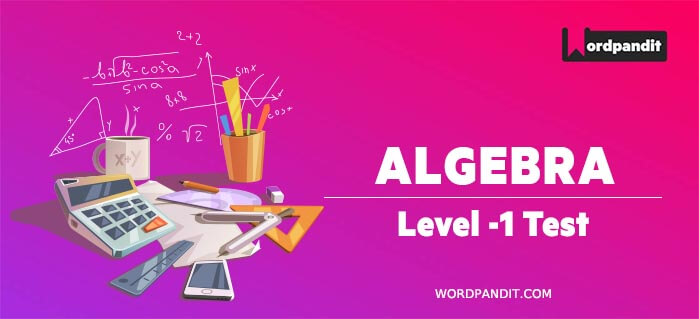- This is an assessment test.
- To draw maximum benefit, study the concepts for the topic concerned.
- Kindly take the tests in this series with a pre-defined schedule.
Algebra Level 1 Test 9
Congratulations - you have completed Algebra Level 1 Test 9.You scored %%SCORE%% out of %%TOTAL%%.You correct answer percentage: %%PERCENTAGE%% .Your performance has been rated as %%RATING%%
Your answers are highlighted below.
Question 1 |
The electricity bill of a certain establishment is partly fixed and partly varies as the number of units of electricity consumed. When in a certain month 540 units are consumed, the bill is Rs. 1800. In another month, 620 units are consumed and the bill is Rs. 2040. In yet another month, 500 units are consumed. The bill for that month would be
Rs. 1560 | |
Rs. 1680 | |
Rs. 1840 | |
Rs. 1950 |
Question 1 Explanation:
Let per unit 'cost = Rs. p
Let fixed cost =Rs. q.
540p + q = 1800
620p + q = 2040
From both the equations
P = Rs. 3
Then q =Rs. 80
500p + q = 500 x 3 + 180 =RS. 1680
Let fixed cost =Rs. q.
540p + q = 1800
620p + q = 2040
From both the equations
P = Rs. 3
Then q =Rs. 80
500p + q = 500 x 3 + 180 =RS. 1680
Question 2 |
Krishna has some hens and some cows. If the total numbers of animal heads are 59 and the total numbers of feet are 190, how many cows Krishna have?
36 | |
32 | |
23 | |
Cannot be determined |
Question 2 Explanation:
Since the hen has 2 legs and a cow has 4 legs and each
animal has one head.
Let the number of cows = p
Let the number of hens = q
Then p + q = 59
and 4p + 2q = 190
From both the equations
p = 36
animal has one head.
Let the number of cows = p
Let the number of hens = q
Then p + q = 59
and 4p + 2q = 190
From both the equations
p = 36
Question 3 |
The cost of 3 chairs and 10 tables is Rs. 9856. What is the cost of 6 chairs and 20 tables?
Rs. 17227 | |
Rs. 19712 | |
Rs. 19172 | |
Cannot be determined |
Question 3 Explanation:
The cost of 3 Chairs + 10 Tables =Rs. 9856
Therefore 2 x (3 Chairs + 10 Tables) = 2 x 9856
Hence the cost of 6 Chairs + 20 Tables would be = Rs. 19712
Therefore 2 x (3 Chairs + 10 Tables) = 2 x 9856
Hence the cost of 6 Chairs + 20 Tables would be = Rs. 19712
Question 4 |
Varoon went to a shop and was shown some shirts costing Rs. 100 each and some trousers costing Rs. 150 each. If he had, Rs. 1200 with him, what was the maximum number of trousers that he could have purchased it, if he had also wanted to purchase some shirts?
2 | |
3 | |
6 | |
8 |
Question 4 Explanation:
Given that the money owned by man = 1200
Since he has to purchase both shirts and trousers.
So the number of trousers and shirts he can buy would be = 6 and 2 respectively
he purchase 6 trousers and 2 shirts because, if he purchase 1 shirt, then Rs. 50 will be left.
Since he has to purchase both shirts and trousers.
So the number of trousers and shirts he can buy would be = 6 and 2 respectively
he purchase 6 trousers and 2 shirts because, if he purchase 1 shirt, then Rs. 50 will be left.
Question 5 |
A manufacturer of a certain item can sell all he can produce at the selling price of ~ 60 each. It costs him Rs. 40 in materials and labor to produce each item and he has overhead expenses of f 3000 per week in order to operate that plant. The number of units he should produce and sell in order to make a profit of at least f 1000 per week is
300 | |
400 | |
250 | |
200 |
Question 5 Explanation:
Let the production = p units
Therefore according to the question
(60 – 40) p – 3000 = 1000
20p = 4000
p = 200
Therefore according to the question
(60 – 40) p – 3000 = 1000
20p = 4000
p = 200
Once you are finished, click the button below. Any items you have not completed will be marked incorrect.
There are 5 questions to complete.
List |











